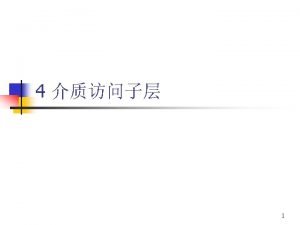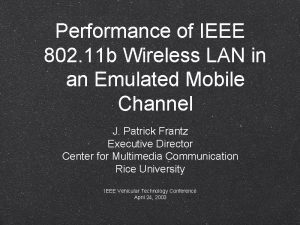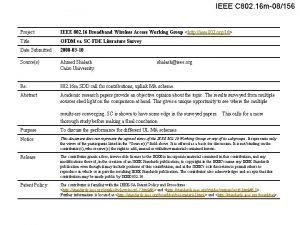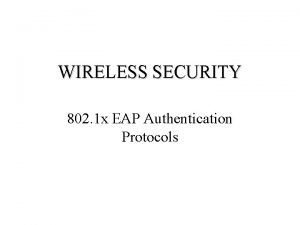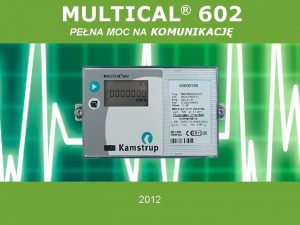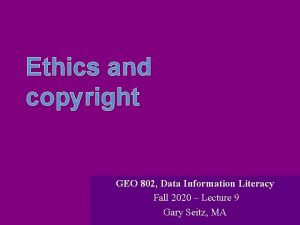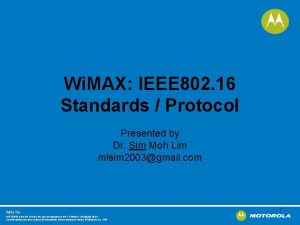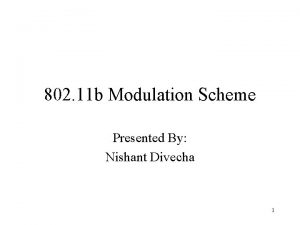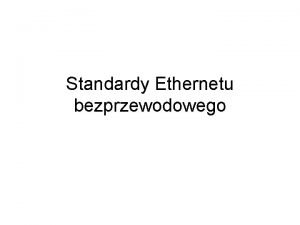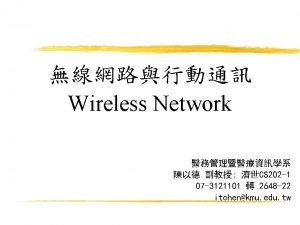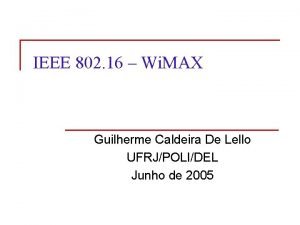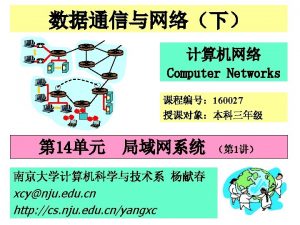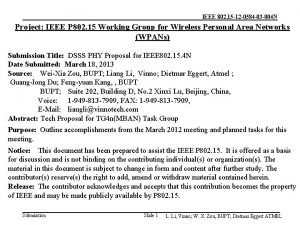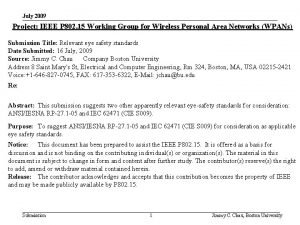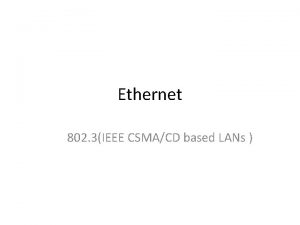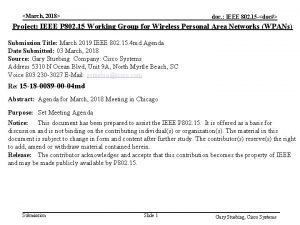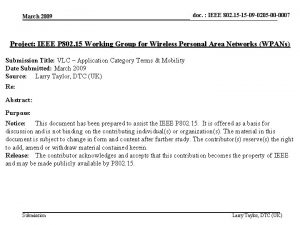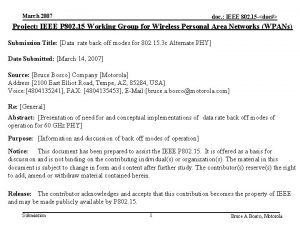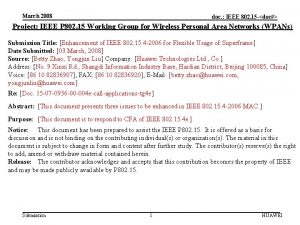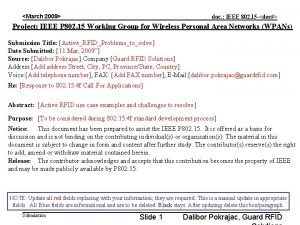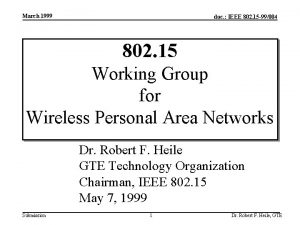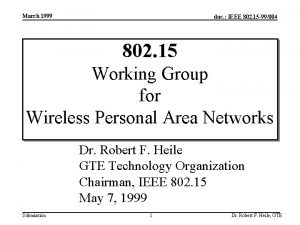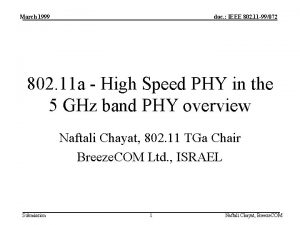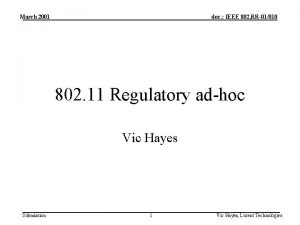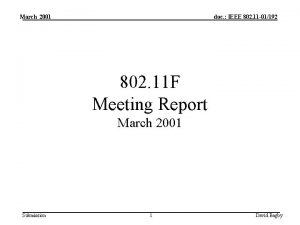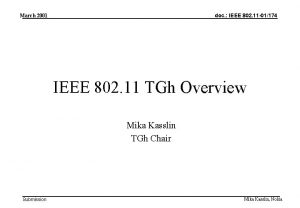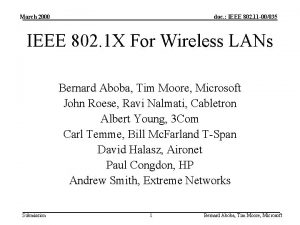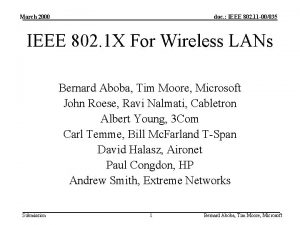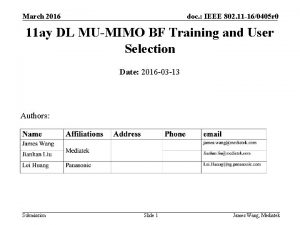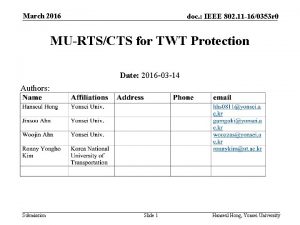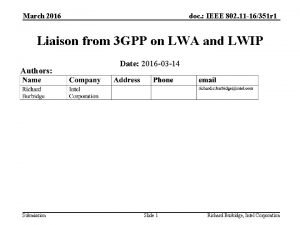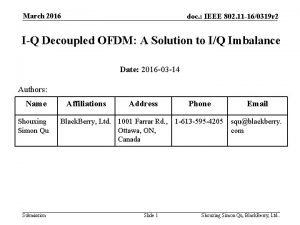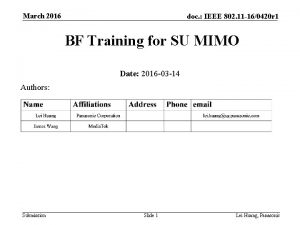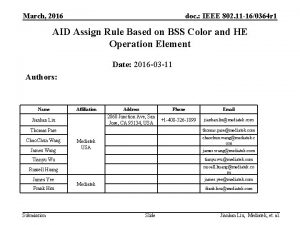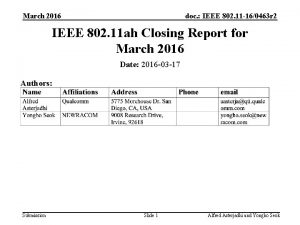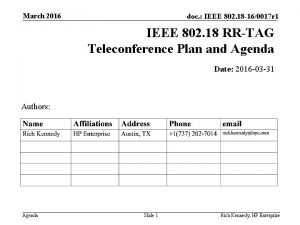March 2016 doc IEEE 802 11 160317 r




























![March 2016 doc. : IEEE 802. 11 -16/0317 r 0 References [YY 11] S. March 2016 doc. : IEEE 802. 11 -16/0317 r 0 References [YY 11] S.](https://slidetodoc.com/presentation_image_h/bfab5c1f05fb109c9d8f19616e94b848/image-29.jpg)
- Slides: 29

March 2016 doc. : IEEE 802. 11 -16/0317 r 0 BATS: Network Coding for Wireless Relay Networks Date: 2016 -03 -14 Authors: Submission Slide 1 R. W. Yeung & S. Yang, CUHK

March 2016 doc. : IEEE 802. 11 -16/0317 r 0 Highlights • BATS code stands for ‘BATched Sparse code’ • The most advanced network coding technology for wireless networks • Significantly improves the multi-hop relay throughput, and/or reduces delay • Throughput benefits in the following applications: • • Submission Multi-hop transmission Multicast Content distribution Internet of things Slide 2 R. W. Yeung & S. Yang, CUHK

March 2016 doc. : IEEE 802. 11 -16/0317 r 0 Outline • • Introduction to BATS Code Protocol Design Implementations Applications in Wireless Relay Networks Submission Slide 3 R. W. Yeung & S. Yang, CUHK

March 2016 doc. : IEEE 802. 11 -16/0317 r 0 1. Introduction to BATS code Submission Slide 4 R. W. Yeung & S. Yang, CUHK

March 2016 doc. : IEEE 802. 11 -16/0317 r 0 Loss & Relay are Inevitable • WLAN has more and more interference in both 2. 4 GHz and 5 GHz Ø Higher loss due to interference • Higher frequency in millimeter wave spectrum, e. g. , 60 GHz to be adopted in 802. 11 AD and 5 G Ø Higher loss due to obstacles Ø Relay for non-line-of-sight transmission • Low power transmission in Io. T Ø Higher loss due to power constraints Ø Relay for long distance transmission Submission Slide 5 R. W. Yeung & S. Yang, CUHK

March 2016 doc. : IEEE 802. 11 -16/0317 r 0 Multi-hop Networks with Packet Loss S R 1 R 2 R 3 T All links have a packet loss rate 10% Intermediate Operation Maximum Rate Forwarding 0. 9 n Network coding 0. 9 n is number of hops. Submission Slide 6 R. W. Yeung & S. Yang, CUHK

March 2016 doc. : IEEE 802. 11 -16/0317 r 0 Random Linear Network Coding • High encoding/decoding complexity • High intermediate node caching/recoding complexity • High coefficient vector overhead Submission Slide 7 R. W. Yeung & S. Yang, CUHK

March 2016 doc. : IEEE 802. 11 -16/0317 r 0 Low Complexity Linear Network Coding • BATS codes [YY 11, YY 14] • Combine fountain codes with random linear network coding • Rateless codes • Coding-based chunked codes [Tang 12, MAB 12, YT 14] • Using LDPC codes to construct random linear network coding • Fixed-rate codes • Modified fountain codes for network coding [PFS 05, CHKS 09, GS 08, TF 11] • Network coding changes the degree distribution • Cannot reduce coefficient vector overhead Submission Slide 8 R. W. Yeung & S. Yang, CUHK

March 2016 doc. : IEEE 802. 11 -16/0317 r 0 BATS Code in a Nutshell • A BATS code includes an outer code and an inner code • The outer code is a matrix fountain code at the source node • The inner code consists of random linear network coding at the intermediate network nodes Submission Slide 9 R. W. Yeung & S. Yang, CUHK

March 2016 doc. : IEEE 802. 11 -16/0317 r 0 Outer Code 1. Obtain a degree d by sampling a degree distribution Ψ 2. Pick d distinct input packets randomly 3. Generate a batch of M coded packets using the d packets b 1 b 2 X 1 b 3 b 4 b 5 X 2 b 6 b 7 X 3 Encoding of batches: Xi = Bi. Gi Submission Slide 10 R. W. Yeung & S. Yang, CUHK

March 2016 doc. : IEEE 802. 11 -16/0317 r 0 Inner Code • The batches traverse the network. • Encoding at the intermediate nodes forms the inner code. • Linear network coding is applied in a causal manner within a batch. …, X 3, X 2, X 1 S Network with linear network coding …, Y 3, Y 2, Y 1 T Transmission of batches: Yi = Xi. Hi Submission Slide 11 R. W. Yeung & S. Yang, CUHK

March 2016 doc. : IEEE 802. 11 -16/0317 r 0 Belief Propagation Decoding 1. Find a check node i with degreei = rank(Gi. Hi) 2. Decode the ith batch 3. Update the decoding graph. Repeat 1. b 1 b 2 G 1 H 1 b 3 b 4 b 5 G 2 H 2 b 6 b 7 G 3 H 3 Associated with a batch is a system of linear equations: Yi = Xi. Hi = Bi. Gi. Hi Submission Slide 12 R. W. Yeung & S. Yang, CUHK

March 2016 doc. : IEEE 802. 11 -16/0317 r 0 Multi-Hop Transmission Fountain Code 10 Mbps 10% loss BATS Code 10% loss 10 Mbps 10% loss 8. 1 Mbps 9 Mbps 10% loss 10 Mbps 10% loss 6. 6 Mbps 7. 3 Mbps 10% loss 10 Mbps 10% loss Traditional approaches accumulate packet loss in multi-hop transmission, while BATS code compensates packet loss hop-by-hop. Submission Slide 13 R. W. Yeung & S. Yang, CUHK

March 2016 doc. : IEEE 802. 11 -16/0317 r 0 Relative Throughput Comparison of BATS and Fountain 1 0. 9 0. 8 0. 7 0. 6 0. 5 0. 4 0. 3 0. 2 0. 1 0 BATS (10% loss) Fountain (10% loss) BATS (20% loss) Fountain (20% loss) 1 2 3 4 5 6 No. of Hops 7 8 9 10 For a network of L hops each with loss rate e, throughput of BATS =1 -e , vs throughput of Fountain =(1 -e)L. Submission Slide 14 R. W. Yeung & S. Yang, CUHK

March 2016 doc. : IEEE 802. 11 -16/0317 r 0 BATS vs RLNC • Much lower computation complexity (99. 9% lower) • Much smaller coding overhead (98% smaller) Coding overhead Encoding complexity Decoding complexity Intermediate node caching BATS O(1) RLNC O(K) O(K 2) O(K) *RLNC stands for Random Linear Network Coding **For transmitting 1000 packets of size 1 K bytes Submission Slide 15 R. W. Yeung & S. Yang, CUHK

March 2016 doc. : IEEE 802. 11 -16/0317 r 0 Achievable Rates of BATS Codes Submission Slide 16 R. W. Yeung & S. Yang, CUHK

March 2016 doc. : IEEE 802. 11 -16/0317 r 0 Analysis of BATS Codes • Asymptotic analysis provides • An approach to characterize the achievable rates of BATS codes • An approach to optimize the degree distribution • Finite-length analysis enables • Exact characterization of BP/inactivation decoding performance • Fine-tuning of the degree distributions Submission Slide 17 R. W. Yeung & S. Yang, CUHK

March 2016 doc. : IEEE 802. 11 -16/0317 r 0 Inactivation Decoding • Inactivation decoding can significantly reduce the coding overhead for BATS code with short block lengths No. of Packets Coding overhead No. of Inactivation Ave. Max Min 1600 2. 04 16 0 94 119 72 8000 6. 30 77 0 215. 5 268 179 16000 26. 58 1089 0 352. 2 379 302 Simulation results of inactivation decoding (M=32, q=256) Submission Slide 18 R. W. Yeung & S. Yang, CUHK

March 2016 doc. : IEEE 802. 11 -16/0317 r 0 Inner Code Design • Systematic adaptive recoding • Reduce computation cost • Increase the achievable rate with the same batch size • Interleaved transmission • Improve the performance with burst loss • No delay accumulation at intermediate nodes Submission Slide 19 R. W. Yeung & S. Yang, CUHK

March 2016 doc. : IEEE 802. 11 -16/0317 r 0 2. Protocol Design Submission Slide 20 R. W. Yeung & S. Yang, CUHK

March 2016 doc. : IEEE 802. 11 -16/0317 r 0 BATS Protocol output file Input file BATS encoding Batch forwarding BATS decoding Batch forwarding BATS enabled APP Existing TCP BATS enabled TCP Existing IP BATS enabled IP Existing MAC BATS enabled MAC PHY Submission Slide 21 R. W. Yeung & S. Yang, CUHK

March 2016 doc. : IEEE 802. 11 -16/0317 r 0 3. Implementation Submission Slide 22 R. W. Yeung & S. Yang, CUHK

March 2016 doc. : IEEE 802. 11 -16/0317 r 0 BATS Code Implementations • BATS recoding has been implemented using low-end wireless routers. • 10 Mbps can be achieve using a single core • Using a particular CPU, >500 Mbps decoding throughput can be achieved. • Gbps throughput can be achieved using CPU, GPU or hardware accelerator. Submission Slide 23 R. W. Yeung & S. Yang, CUHK

March 2016 Submission doc. : IEEE 802. 11 -16/0317 r 0 Slide 24 R. W. Yeung & S. Yang, CUHK

March 2016 doc. : IEEE 802. 11 -16/0317 r 0 4. Applications in Wireless Relay Networks Submission Slide 25 R. W. Yeung & S. Yang, CUHK

March 2016 doc. : IEEE 802. 11 -16/0317 r 0 Application: Multi-hop Networks • Satellite • Video/signal relays for automobiles • Video relays for traffic surveillance • Wireless access point extender • HDMI repeater Submission Slide 26 R. W. Yeung & S. Yang, CUHK

March 2016 doc. : IEEE 802. 11 -16/0317 r 0 Application: Multicast Delivery • Shared video in conference rooms • Shared video in concerts/sport games/classrooms • TV broadcasting with relays Submission Slide 27 R. W. Yeung & S. Yang, CUHK

March 2016 doc. : IEEE 802. 11 -16/0317 r 0 Application: Internet of Things • Device-to-device networks • Sensor networks • Mobile networks • Wireless relays for drones Submission Slide 28 R. W. Yeung & S. Yang, CUHK
![March 2016 doc IEEE 802 11 160317 r 0 References YY 11 S March 2016 doc. : IEEE 802. 11 -16/0317 r 0 References [YY 11] S.](https://slidetodoc.com/presentation_image_h/bfab5c1f05fb109c9d8f19616e94b848/image-29.jpg)
March 2016 doc. : IEEE 802. 11 -16/0317 r 0 References [YY 11] S. Yang and R. W. Yeung, “Coding for a network coded fountain, ” ISIT 2011. [YY 14] S. Yang and R. W. Yeung, “Batched sparse codes, ” IEEE Trans. Inform. Theory, vol. 60, no. 9, Sep. 2014. [Tang 12] B. Tang, S. Yang, Y. Yin, B. Ye and S. Lu, “Expander graph based overlapped chunked codes, ” ISIT 2012. [YT 14] S. Yang and B. Tang, “From LDPC to chunked network codes, ” ITW 2014. [YZ 15] S. Yang and Q. Zhou, “Tree Analysis of BATS Codes, " IEEE Comm. Letters 2016. [NY 13] T-C Ng and S. Yang, “Finite-Length Analysis of BATS Codes, ” Net. Cod 2013. [YNY 15] S. Yang, T-C Ng and R. W. Yeung, “Finite-Length Analysis of BATS Codes, ” Ar. Xiv 2016. [Huang 14] Q. Huang, K. Sun, X. Li, and D. O. Wu, “Just fun: A joint fountain coding and network coding approach to losstolerant information spreading, ” Mobile Ad Hoc 2014. [YYCY 14] S. Yang, R. W. Yeung, H. F. Cheung, and H. H. Yin, “BATS: Network coding in action, ” Allerton 2014. [XGGC 14] X. Xu, P. K. M. Gandhi, Y. L. Guan, and P. H. J. Chong, “Two-phase cooperative broadcasting based on batched network code, ” ar. Xiv 2015. Submission Slide 29 R. W. Yeung & S. Yang, CUHK
 Bridges from 802.x to 802.y
Bridges from 802.x to 802.y Bridges from 802.x to 802.y
Bridges from 802.x to 802.y Poland national anthem lyrics
Poland national anthem lyrics Ieee 802 family
Ieee 802 family Ieee 802 3 compliance
Ieee 802 3 compliance Wlan standards
Wlan standards Arquitetura ieee 802
Arquitetura ieee 802 Estandares 802
Estandares 802 Ieee 802 standard
Ieee 802 standard 802 15
802 15 802 ieee
802 ieee Ieee 802
Ieee 802 802 3
802 3 802 11 b
802 11 b 802-11-iapp
802-11-iapp Nn dfe
Nn dfe 802 eap
802 eap Kamstrup multical 802
Kamstrup multical 802 Geo 802
Geo 802 802 16
802 16 802 11
802 11 Standardy 802
Standardy 802 802 5
802 5 802 family
802 family 802 16
802 16 802 protocols
802 protocols 802 15
802 15 Sybex ccna
Sybex ccna 09 802 0561
09 802 0561 Ethernet 802
Ethernet 802












